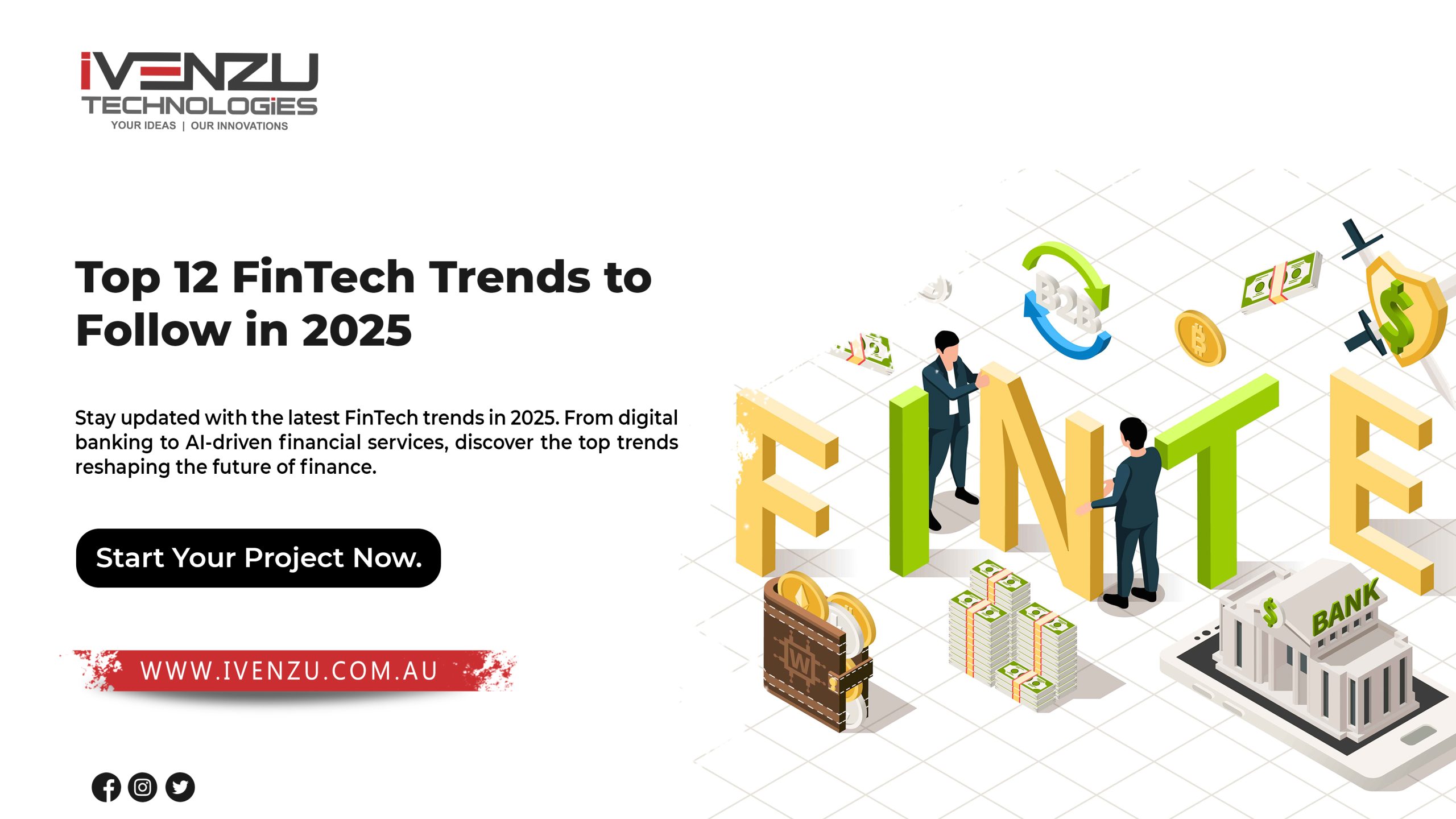Top 12 FinTech Trends to Follow in 2025
Stay updated with the latest FinTech trends in 2025. From digital banking to AI-driven financial services, discover the top trends reshaping the future of finance.

The Future of Finance in 2025
The world of financial technology, or FinTech, is evolving rapidly, and 2025 promises to bring groundbreaking innovations that will redefine how we manage money, invest, and interact with financial institutions. From the growth of digital banking to the integration of artificial intelligence (AI) and blockchain, FinTech continues to disrupt traditional financial services, providing more efficient, accessible, and secure solutions.
In this blog post, we’ll explore the top 12 FinTech trends you should follow in 2025 to stay informed and capitalise on new opportunities.
1. Digital-Only Banks
Digital-only or challenger banks are becoming increasingly popular as consumers demand more convenient and efficient banking experiences. These banks operate entirely online, without physical branches, offering services such as savings accounts, loans, and payments through mobile apps or websites.
Trend Overview:
-
- Consumers are shifting away from traditional brick-and-mortar banks.
- Digital-only banks offer lower fees and better customer service.
- Popular examples: Chime, Monzo, Revolut.
In 2025, these digital-first banks will expand their offerings with innovative financial products tailored to specific customer needs.
2. Artificial Intelligence (AI) in FinTech
AI is transforming FinTech by enhancing customer experience, automating tasks, and improving decision-making. From personalised financial advice to fraud detection, AI algorithms analyse large amounts of data to optimise financial services.
Trend Overview:
-
- AI-powered chatbots and virtual assistants streamline customer service.
- AI in lending assesses borrower risk more accurately.
- Machine learning helps with personalised financial recommendations.
As AI technology continues to evolve, more FinTech companies will incorporate advanced AI tools to provide better and faster services.
3. Blockchain and Cryptocurrency Advancements
Blockchain technology and cryptocurrencies have revolutionised finance in recent years, and their role will continue to grow in 2025. Blockchain’s decentralised nature enhances security, transparency, and efficiency in transactions.
Trend Overview:
-
- Cryptocurrencies like Bitcoin and Ethereum will continue to gain mainstream adoption, particularly in remittances, cross-border payments, and digital asset management.
- Smart contracts will further automate financial agreements without intermediaries.
- Blockchain’s potential in supply chain financing and trade finance will expand.
Expect new blockchain-based financial products and services that offer greater transparency and lower transaction costs.
4. RegTech (Regulatory Technology)
RegTech uses technology to help businesses comply with regulations more efficiently and effectively. RegTech solutions are essential for managing risks, ensuring compliance, and avoiding fines in a world with increasing regulatory scrutiny.
Trend Overview:
-
- KYC (Know Your Customer) and AML (Anti-Money Laundering) technologies powered by AI and machine learning will streamline compliance processes.
- Blockchain will play a significant role in improving regulatory transparency.
RegTech is becoming crucial for both FinTech startups and established financial institutions to manage compliance efficiently and mitigate legal risks.
5. Embedded Finance
Embedded finance refers to the integration of financial services into non-financial platforms. It allows companies to directly offer financial products such as lending, payments, and insurance through their digital interfaces.
Trend Overview:
-
- Companies across industries incorporate financial products, like insurance, into their offerings.
- Buy Now, Pay Later (BNPL) services are embedded into e-commerce platforms, allowing customers to pay for goods and services in instalments.
- Embedded payments simplify transactions across e-commerce, ride-sharing apps, and other services.
By 2025, embedded finance will continue to blur the lines between traditional financial services and everyday digital experiences.
6. Buy Now, Pay Later (BNPL) Growth
BNPL services allow consumers to purchase goods and services and pay for them in instalments, often without interest. The popularity of BNPL has exploded, and the trend is set to grow in 2025.
Trend Overview:
-
- BNPL services like Affirm, Afterpay, and Klarna are now widely accepted by retailers.
- BNPL providers are expanding their offerings to include larger purchases, interest-free loans, and payment deferrals.
- Increased regulation of BNPL services to prevent consumer debt risks.
In 2025, expect BNPL services to become more mainstream, with stricter regulations and further integrations into e-commerce platforms.
7. Robo-Advisors and Wealth Management
Robo-advisors are AI-powered platforms that provide automated investment advice. They allow users to access low-cost, personalised wealth management services, making investing more accessible to individuals without high capital.
Trend Overview:
-
- Robo-advisors offer personalised portfolio management based on an individual’s risk tolerance and financial goals.
- AI and machine learning will continue to enhance robo-advisor algorithms for better predictions and recommendations.
- Popular platforms: Betterment, Wealthfront, SoFi.
In 2025, robo-advisors will continue democratising wealth management, offering more sophisticated financial advice at lower costs.
8. Neobanks and Challenger Banks
Neobanks, or digital banks, are fintech firms that provide banking services without physical branches. These institutions typically offer services like savings accounts, credit cards, and personal loans via mobile apps or online platforms.
Trend Overview:
-
- Neobanks are increasingly focusing on personalised customer experiences, low fees, and attractive interest rates.
- They target younger, tech-savvy consumers who prioritise digital-first solutions over traditional banking.
- Well-known neobanks: Chime, N26, Starling Bank.
As the demand for digital-first banking continues, expect neobanks to gain significant market share in 2025.
9. Cybersecurity and Fraud Prevention
Cybersecurity remains a top priority for FinTech companies. As digital payments, online banking, and cryptocurrencies grow, so does the risk of cyber threats and fraud.
Trend Overview:
-
- AI-driven fraud detection systems will become more advanced, detecting suspicious activities in real time.
- Blockchain’s decentralised nature enhances security for digital payments and transactions.
- Increased focus on multi-factor authentication (MFA) and biometric security measures.
In 2025, we’ll see FinTech companies investing heavily in cybersecurity solutions to protect both their customers and themselves from evolving threats.
10. Decentralised Finance (DeFi)
Decentralised Finance (DeFi) refers to blockchain-based financial systems that aim to replace traditional banking institutions, eliminating intermediaries for services like lending, borrowing, and trading.
Trend Overview:
-
- DeFi will continue to grow, with platforms offering decentralised exchanges (DEX), lending protocols, and stablecoins.
- DeFi is appealing because it enables borderless and permissionless financial services with greater transparency and lower costs.
- Ethereum and Polkadot will remain at the forefront of DeFi development.
2025 will be the year that DeFi reaches new heights, potentially disrupting traditional financial services more widely.
11. Open Banking
Open Banking allows third-party financial services providers to access banking data and offer innovative financial products via APIs. It fosters competition and enables consumers to make more informed financial decisions.
Trend Overview:
-
- Open Banking enables personal finance management (PFM) apps, alternative lending platforms, and innovative payment solutions.
- Increased adoption globally as countries pass regulations encouraging open banking.
- Data privacy and security will remain critical as more financial data is shared across platforms.
As regulations evolve, open banking will expand its reach and continue driving innovation in 2025.
12. Sustainable and Green FinTech
Sustainable investing and green finance have gained significant traction in recent years, and FinTech is playing a crucial role in promoting these initiatives. Green FinTech refers to the use of technology to facilitate environmentally friendly financial services.
Trend Overview:
-
- Investors are increasingly focusing on companies that support sustainability and climate change mitigation.
- Green bonds, sustainable investment funds, and carbon trading platforms will continue to grow in popularity.
- ESG (Environmental, Social, and Governance) factors will influence investment decisions and lending practices.
In 2025, green FinTech solutions will become mainstream, and more financial services will integrate sustainability into their offerings.
Stay Ahead in the FinTech Revolution
The FinTech landscape in 2025 promises to be full of opportunities and challenges. From AI-powered services to blockchain innovations, the future of finance is more digital, efficient, and customer-centric than ever before. By staying informed about these top FinTech trends, you can harness the power of technology to drive growth, improve financial services, and stay competitive in an ever-evolving industry.
As FinTech continues to disrupt traditional finance, keep an eye on emerging trends and technologies to ensure you remain ahead of the curve.
Your questions and answered
1. What are the top FinTech trends to watch in 2025?
The top FinTech trends in 2025 include digital-only banks, artificial intelligence in financial services, blockchain and cryptocurrency advancements, embedded finance, BNPL (Buy Now, Pay Later), and the rise of sustainable or green FinTech solutions.
2. Why is FinTech important in 2025?
FinTech is reshaping the financial industry by making services faster, more accessible, secure, and user-friendly. In 2025, its importance lies in enabling innovation, enhancing financial inclusion, and driving digital transformation in banking and finance.
3. What is the difference between FinTech and traditional banking?
FinTech uses advanced technology like AI, blockchain, and mobile apps to deliver financial services, often without physical branches. Traditional banks operate through brick-and-mortar locations and are generally slower to adopt cutting-edge tech solutions.
4. How will AI impact FinTech in 2025?
AI will improve customer experience, automate financial processes, detect fraud, and provide personalized financial recommendations. AI-driven tools like robo-advisors and chatbots are expected to become even more sophisticated in 2025.
5. Is blockchain still relevant in 2025 FinTech trends?
Yes, blockchain remains highly relevant. It enhances transparency, reduces transaction costs, and supports decentralized finance (DeFi) platforms. In 2025, it will continue to play a key role in secure transactions and smart contract automation.
6. What is embedded finance and why does it matter?
Embedded finance integrates financial services into non-financial platforms (e.g., ride-sharing or e-commerce apps). It matters because it allows businesses to offer seamless payment, lending, and insurance solutions directly within their ecosystem.
7. Are Buy Now, Pay Later (BNPL) services safe to use?
BNPL services are generally safe when used responsibly. However, with their growing popularity in 2025, regulatory frameworks are tightening to protect consumers from overspending and accumulating debt.
8. What is RegTech and how does it support compliance?
RegTech, or Regulatory Technology, uses AI and blockchain to help companies comply with financial regulations more efficiently. It automates KYC, AML checks, and real-time reporting, reducing compliance costs and risks.
9. What are neobanks, and how do they differ from traditional banks?
Neobanks are 100% digital banks without physical branches. They typically offer lower fees, faster onboarding, and modern user interfaces compared to traditional banks. They’re popular with tech-savvy users seeking convenience and innovation.
10. What is green or sustainable FinTech?
Green FinTech refers to financial technologies that promote environmentally sustainable investments and services. This includes tools that support carbon tracking, ESG investing, green bonds, and financing clean energy initiatives.
More Latest Blog
Complete Project Management Guide: Best Practices, Tools, and Methodologies Project management is the process of planning, organising, and...
Are Ads Free on LinkedIn? Complete 2025 Guide to LinkedIn Advertising Costs & Options LinkedIn is the go-to platform for professionals...
A Comprehensive Guide to Magento Web Development: Mastering E-Commerce Success In today’s fast-paced digital economy, having a robust e-commerce...
AI and Software Engineers: The Future of Technology In this article, we will explore the relationship between AI and software engineers, the role of...





